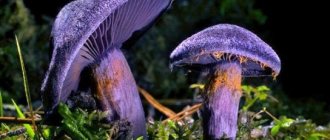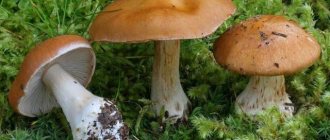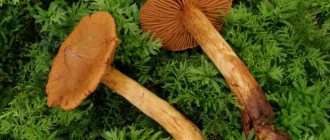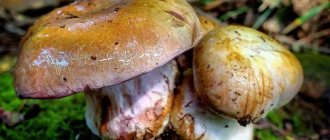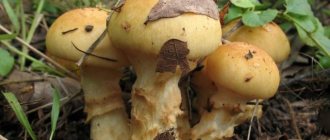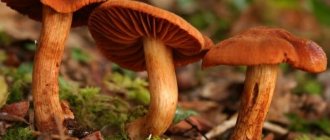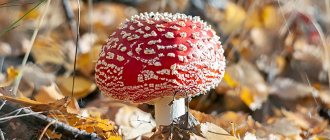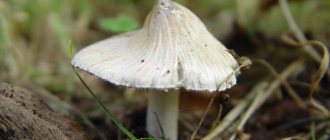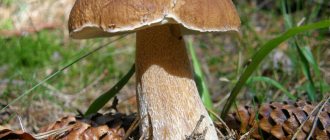There are few mushrooms that can be instantly identified by their smell. Goat's web is just one of these. If you are a purely city dweller and the expression “stinking like a goat” has a purely theoretical meaning for you, then this mushroom will help you fully appreciate the validity of this expression.
He smells like a goat in the most natural way. Others rate the smell as acetylene. And the inedibility of this mushroom is not due to the fact that it can cause any harm to health. It’s just that only a person who is completely devoid of smell can eat dishes made from this mushroom. When cooked, the goat stench not only does not disappear, but also intensifies many times over.
Description
Goat's web.
hat
At a young age, it has a hemispherical shape with edges bent inward; during development and growth, the cap flattens slightly, taking the shape of a hemisphere with a slight elevation in the center. The structure of the cap is dense and fleshy. The skin is velvety to the touch, dry, and a little sticky after rain.
The color of the cap is a mixture of purple and brown, and in young specimens the caps are brighter, with a predominance of purple, and with age the color gradually fades, turning into brown tones. The cap size is up to 12 cm in diameter.
Goat's web.
Spore-bearing layer
Lamellar. The hymenophore of young mushrooms is hidden by a protective cover - a “cobweb”, quite dense. This provides a favorable microclimate for spore maturation.
The plates initially match the color of the cap, but soon after breaking the covers quickly become brown with a rusty tint. They are often located, growing to the leg. The spore powder is brown in color with a rusty tint; almond-shaped spores with a rough surface.
Leg
The cobweb is stinky.
At the beginning of growth, it is shortened, massive, thick, with a pronounced tuber-shaped thickening at the base. As the fruiting body grows, it gradually levels out, acquiring a regular cylindrical shape. It reaches a height of 7 to 11 cm, a thickness of 1 to 3 cm.
Along its entire length, characteristic violet bands are noticeable; the general color matches the cap, but is somewhat lighter. When the mushroom ripens, reddish spots appear on the surface of the stem - traces of spore powder. The structure is dense, elastic, solid.
Pulp
Bureau-violet color, loose in the cap, dense in the stem. At the site of a break or cut, the color does not change and does not emit milky juice. Has a strong unpleasant odor, described as acetylene or like the smell of goat hair.
Eating
All edible types of spider webs are edible only after careful heat treatment; they cannot be eaten raw.
Useful properties and restrictions on use
Since most of the cobwebs are not used as food due to their inedibility and toxicity, and edible species are not recognized as particularly valuable and are easily confused with false ones, the beneficial properties of this genus of mushrooms are inferior to others. However, they find practical use in medicine to extract some valuable substances for medicines.
Useful properties of spider webs
Marsh plants are well known as high-quality raw materials for the production of various types of dyes, especially shades of ocher. Conditionally and unconditionally edible species of spider webs, after prolonged boiling with draining of the broth, are used to prepare various dishes, but they are not recommended for consumption by people with gastrointestinal pathologies and children of any age.
Recipes and cooking features
The three types of undeniably edible botanicals described above can be cooked after a short boil. The remaining conditionally edible varieties, after preliminary cleaning and before cooking, must be boiled for a long time in several stages, draining the broth after 5-10 minutes of boiling. After this, they can be salted, pickled, fried and canned, and prepared as first and second courses. It should be taken into account that the dishes will have a specific nutty taste.
You may be interested in:
How to distinguish volushki from saffron milk caps and how are they similar (20 photos)? Some of the most popular mushrooms in our country are considered to be mushrooms and saffron milk caps. These species are very similar to an inexperienced...Read more...
Gossamer Dish
In addition, different types require certain cooking methods:
- It is better to fry and boil gray-blue marsh marshes.
- The scaly mushroom is eaten only boiled.
- The triumphal and excellent types are dried and salted.
Some conditionally edible varieties with brightly colored flowers are successfully used to decorate other dishes. In all other respects, preparing cobwebs is no different from many other recipes.
Spreading
Cortinarius traganus.
It is often found throughout the European territory of Russia, in Siberia and up to the Far East. It grows in both coniferous and mixed forests, preferring moist areas covered with moss. Found singly or in small groups.
The period of active fruiting continues throughout the warm period of the summer-autumn season.
Time and place of fruiting
As a rule, goat's web most often grows in coniferous and mixed forests (mainly where there are pine trees). It can be found in damp, mossy areas.
On the territory of the Russian Federation, the mushroom bears fruit in the following areas:
- Leningradskaya;
- Murmanskaya;
- Sverdlovskaya;
- Vologda;
- Yaroslavskaya.
It was noticed by mushroom pickers in the Krasnoyarsk Territory, as well as in Tatarstan and Buryatia. As for Europe, it can be found in the Czech Republic, Austria, Great Britain, Belgium, Hungary, Germany, Poland, Denmark, Estonia, Slovakia, Lithuania, Switzerland and Finland. But in North America and Africa, cobwebs do not grow.
The fruiting period begins in July and ends in late September - early October.
Similar species
- Camphor cobweb.
Almost indistinguishable in appearance, differs only in the smell of the pulp. As the name of the species suggests, it has the smell of camphor. Inedible.
- The spider web is white and purple.
It has a brighter and more saturated color, and according to the description, it has an even more disgusting smell of pulp (if such a thing is even possible). A rare inedible mushroom.
- Gossamer violet.
The mushroom is completely colored in an intense purple color, the hymenophores are bright red in color. A very rare mushroom, listed in the Red Book.
1-Camphora cobweb. 2-Spiderweb white-violet. 3-Violet cobweb.
Spider web mushroom
We offer a description and photo of various types and varieties of spider webs - this information will help diversify quiet forest hunting and make it more productive.
Look at the poisonous and edible spider web mushroom in the photo and try to find it in the forest during your next outing:
Spider web mushroom in the photo
Spider web mushroom in the photo
Interesting Facts
Goat's web.
Kozhemyako Boris Lvovich
An experienced mushroom picker who knows a lot about finding mushrooms
Not long ago, information appeared on the Internet about the discovery of a rare variety of purple spider web, which has a caramel smell and excellent taste. However, this news was isolated and was not confirmed in any way.
— Kozhemyako Boris Lvovich An experienced mushroom picker who knows a lot about finding mushrooms
Definitioner
Basidia (Basidia)
Lat. Basidia. A specialized structure of sexual reproduction in fungi, unique to basidiomycetes. Basidia are terminal (end) elements of hyphae of various shapes and sizes, on which spores develop exogenously (outside).
Basidia vary in structure and method of attachment to hyphae.
Based on the position relative to the axis of the hyphae to which they are attached, three types of basidia are distinguished:
Apical basidia are formed from the terminal cell of the hypha and are located parallel to its axis.
Pleurobasidia are formed from lateral processes and are located perpendicular to the axis of the hypha, which continues to grow and can form new processes with basidia.
Subbasidia are formed from a lateral process turned perpendicular to the hyphal axis, which stops growing after the formation of one basidium.
Based on morphology:
Holobasidia are single-celled basidia, not divided by septa (see Fig. A, D).
Phragmobasidia are divided by transverse or vertical septa, usually into four cells (see Fig. B, C).
By type of development:
The heterobasidium consists of two parts - the hypobasidium and the epibasidium developing from it, with septations (see Fig. C, B) or without them (see Fig. D).
Homobasidia is not divided into hypo- and epibasidia and in all cases is considered to be holobasidium (Fig. A).
The basidium is the site of karyogamy, meiosis, and the formation of basidiospores. Homobasidy, as a rule, is not functionally divided, and meiosis follows karyogamy. However, the basidia can be divided into probasidium, the site of karyogamy, and metabasidium, the site of meiosis. Probasidium is often a resting spore, for example in rust fungi. In such cases, the probasidium germinates into a metabasidium, in which meiosis occurs and on which basidiospores are formed (see Fig. E).
See Karyogamy, Meiosis, Hypha.
Pileipellis
Lat. Pileipellis, skin - a differentiated surface layer of the cap of agaricoid basidiomycetes. The structure of the skin in most cases differs from the inner flesh of the cap and may have a different structure. The structural features of pileipellis are often used as diagnostic characters in descriptions of fungal species.
Based on their structure, they are divided into four main types: cutis, trichoderma, hymeniderma and epithelium.
See Agaricoid fungi, Basidiomycete, Cutis, Trichoderma, Hymeniderma, Epithelium.
KutisThe type of cap skin consists of creeping, ungelatinized hyphae located parallel to the surface. The surface of the cap looks smooth.
Lat. Cutis.
See Hypha.
Recipes for preparing yellow marsh grass
Golden gossamer is used in different forms:
- boiled;
- fried;
- salted;
- pickled;
- canned.
The fruit is usually used as a side dish for main dishes. In this case, young mushrooms are usually used for food. They have a more delicate and rich taste, and are also enriched with essential nutrients.
Primary processing and cooking
After harvesting, mushrooms must be immediately subjected to primary processing, as they tend to quickly lose their shape, appearance, taste and beneficial properties. The preparation stage begins with removing large debris from the surface of the plants - twigs, leaves, etc.
On a note.
The most delicious part of the mushroom are the caps, but it is better to throw away the stems. Of course, if we are not talking about pickling, canning or pickling spider webs.
After this, the fruits only need to be rinsed well under running water - and you can proceed to cooking. Place the mushrooms in a saucepan, add water and add salt to taste. When the mass comes to a boil, reduce the heat to minimum and cook the fruiting bodies for 15-20 minutes. Then drain the water and use the boiled spider webs for frying, freezing, cooking soup, etc.
How to deliciously fry spider webs
You may be interested in: How do edible talkers differ from false mushrooms? How many days after rain do mushrooms grow? Bitter mushroom: photo and detailed description
To enjoy delicious fried mushrooms, you need to adopt the following recipe:
- Boil the mushrooms and drain in a colander.
- Finely chop the onion and fry it in a frying pan until golden brown.
- Then add fruits to it, add spices to taste and cover the container with a lid.
- The frying process lasts from 5 to 10 minutes, after which you can enjoy the finished dish.
Pickling
The recipe is for 1 kg of mushrooms. First you need to prepare them - rinse and clean them. The leg must be cut to half, and if it looks inedible, then it should be removed altogether. After this, each fruit must be cut in half, and large specimens - into 4 parts.
Important!
Spider webs are pickled only after preliminary boiling in salted water.
You need to take the jars, sterilize them over steam and place them on the bottom of each of them:
- dill umbrella;
- 2 cloves of garlic;
- 4 black peppercorns.
Mushrooms need to be packaged in jars before they cool down after cooking. After this, pour the marinade prepared from water (300 ml), vinegar (3 tbsp), salt (2 tbsp) and sugar (3 tsp) over the raw materials, and then immediately roll up the containers. Turn over and leave until completely cool, and then move to the cellar for storage.
Pickling mushrooms
The recipe for pickling cobwebs is very simple. The mushrooms must be pre-cooked, and while this process lasts, you need to prepare a container for pickling. This could be a barrel or a deep enamel pan.
Drain the mushrooms and let them cool completely. Place the fruits in layers in a pickling container, generously sprinkle each layer with coarse rock salt. Carry out this manipulation until you run out of raw materials or space in the barrel/pan.
Cover the top of the mushroom mass with gauze, and then place a plate on it. The last stage is establishing the load. It can be a large stone or a jar of water.
You do not have access to your mi account
Reset the device
An option that does not work for everyone is to try a full reset (wipe) of the device through recovery, this deletes all your data from the phone, this method does not provide a 100% guarantee that the phone will not ask you for a password again. Instructions on how to reset xiaomi can be read here.
Device firmware
If resetting does not help, then perhaps flashing the device's firmware will help. It helped some users, but not all. Devices with a Snapdragon processor must be flashed via fastboot, miflash, and for MTK – via flashtool. Judging by some reviews on the forums, you need to use an old version of the firmware to remove the MI account check when booting your smartphone. It is advisable to use a version up to MIUI 7; if there is not one for your device, then we use, for example, version 7.0.2.0. Unfortunately, we have no confirmation of the functionality of this method. It is quite possible that after flashing the firmware, the smartphone will not ask for a password at first, but as soon as you connect it to the Internet, it may require it from you, since the account is hardwired into the hardware of the smartphone.
Harm
It is also worth mentioning that some types of fruits in question can be very dangerous and poisonous. The problem is that signs of poisoning may only appear after a few days. In some cases, even weeks pass. The bottom line is that such mushrooms contain toxins that slowly poison a person. The dangerous poison begins to have a detrimental effect on the kidneys. As a result, a person may eventually develop a disease in the form of acute interstitial nephritis. In rare cases, there may even be death due to irreversible changes in the structure of the kidneys. According to statistics, when poisoned, 30% of people do not survive. Often the most common signs of poisoning from similar fruits are dryness and burning in the mouth. You may also experience nausea, vomiting, extreme thirst, and abdominal cramps.
In addition, poisoning is often accompanied by pain in the lumbar region and severe migraine. Even if you pay attention to the symptoms of poisoning in time, professional treatment and subsequent recovery will be quite long. To avoid this kind of thing, you must adhere to some rules. Any mushroom picker knows that if doubts creep in whether a fruit is edible or not, it is better to classify it as conditionally poisonous.
Don't rip it off. Collecting cobwebs is best left to professional mushroom pickers. Only experts will be able to accurately distinguish a poisonous mushroom from an edible one.
Most mushroom pickers avoid yellow spider webs. This happens because during such a period many edible fruiting bodies appear, which cannot be confused with poisonous ones. As for edibility, it is prepared quite rarely. The fruits in question require special preparatory measures. You should not collect and try such mushrooms if you are not a professional mushroom picker.
Hormonal factors regulating flowering
It was found that the most important role of phytohormones in the regulation of flowering is played by gibberellins. As was shown in the example of the apple tree, the endogenous gibberellin mechanisms responsible for flowering are to a small extent dependent on the action of exogenous factors. Obviously, GCs perform a regulatory function during the reproductive and vegetative development of the plant, and they are closely related to the mechanisms regulating the frequency of fruiting.
It is known that the development program of the apical meristem along the path of formation of leaves and shoots can “switch” to the formation of floral organs. This switch occurs abruptly, is genetically irreversible, and is believed to be regulated by a massive network of gene regulators. The moment at which such a sharp restructuring occurs is strictly determined by endogenous and exogenous signals. In recent years, families of genes involved in the implementation of these mechanisms have been identified, and their regulatory role has been determined.
